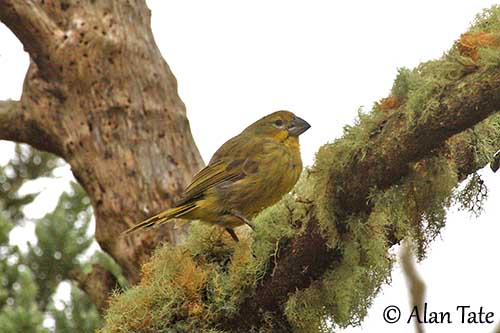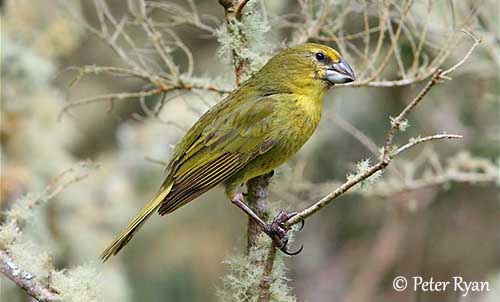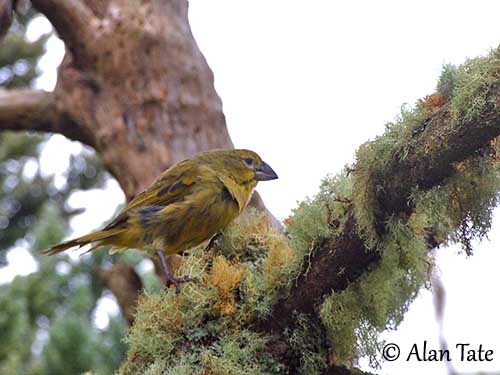
Fr: Nésospize de Wilkins
Ang : Wilkin’s Finch
All: Wilkins-Ammerfink
Esp: Semillero de Wilkins
Ita: Fringuello di Wilkins
Photographers:
Peter Ryan
The Percy Fitzpatrick Institute of African Ornithology
Alan & Ann Tate
AA Bird Photography
Text by Nicole Bouglouan
Sources :
HANDBOOK OF THE BIRDS OF THE WORLD Vol 16 by Josep del Hoyo- Andrew Elliot-David Christie – Lynx Edicions – ISBN: 9788496553781
Conservation Wilkin’s Bunting (Nesospiza wilkinsi) - an endangered, single island endemic.
By Heinz E. Ortmann – February 2013
Supervisor: Dr. Peter G. Ryan
http://adu.org.za/pdf/Ortmann_Heinz_2013_MSc_CB_thesis.pdf
Molecular Phylogenetics and Evolution – The origin of finches on Tristan da Cunha and Gough island, central South Atlantic Ocean
Peter G. Ryan, Luke B. Klicka, Keith F. Barker, Kevin J. Burns
SCIENCE/AAAS
Ecological Speciation in South Atlantic Island Finches
Peter G. Ryan, Paulette Bloomer, Coleen L. Moloney, Tyron J. Grant and Wayne Delport
BirdLife International (BirdLife International)
Red List of Threatened species
Wilkins’s Finch or Grosbeak Bunting
Nesospiza wilkinsi
Passeriformes Order – Thraupidae Family
INTRODUCTION:
The Wilkins’s Finch is rare on Nightingale Island. This endemic species is currently classified as Endangered due to small range and population.
This large-billed finch feeds largely on fruit and seeds from Phylica arborea, a native plant species. This tree is vulnerable to certain invertebrates or pathogens which could reduce the food sources of the Wilkins’s Finch, threatened itself by possible arrival of invasive species and risk of introduction of mammalian predators.
DESCRIPTION OF THE BIRD:
Biometrics:
Length: 20-22 cm
Weight: 41-53 g
The adult is a large, robust bird with large bill.
The male has olive-green upperparts and underparts, although chin, throat, upper breast and submoustachial area are uniformly brighter yellow. The plumage is slightly streaked greyish above and below.
On the head, we can see a yellowish supercilium. Lores and eye’s area are pale grey.
The heavy, deep-based bill is slate grey with paler base of lower mandible. The eyes are dark brown. Legs and feet are dark grey-brown.
The female is slightly smaller than male. She is very similar but her plumage is duller and more streaked.
Juvenile and immature resemble female, but they have mostly buffy-brown plumage, more heavily streaked.

RANGE:
The Wilkins’s Finch is found on Nightingale Island which is part of Tristan da Cunha group, in South Atlantic Ocean.
HABITAT:
The Wilkins’s Finch frequents mainly the areas dominated by Phylica arborea trees but it may also forage in adjacent tussock grassland (Spartina arundinacea). They are more abundant in the Ponds area where woodland occurs.
CALLS AND SONGS: SOUNDS BY XENO-CANTO
The Wilkins’s Finch’s contact call is a chipping call, also given when the Brown Skua is flying over the territory.
Due to the larger bill, both male and female utter deeper and slower song than the Nightingale Island Finch which also occurs on this island. The male’s song is a “whut-prreu whut-preeu” whereas the female gives soft, plaintive whistles.
BEHAVIOUR IN THE WILD:
The Wilkins’s Finch feeds primarily on fruit and seeds from Phylica arborea trees. It crushes the hard, nut-like fruit thanks to its strong bill, in order to reach the seeds. It also takes invertebrates among tussock grass, on the ground and under trees. Immature birds forage mainly in fern-bush habitat.
There is no record of hybridization on the island between the Wilkins’s Finch and the Nightingale Island Finch. The habitat provides two different sizes of seeds with Spartina (small seeds) and Phylica (hard fruit), involving two separate species with different bill sizes.
Each species has a distinctive song and both defend the territory against rivals.
This ecological speciation is the result of an ecological process which also maintains the diversity of the morphology. The Wilkins’s Finch is the largest species of the genus Nesospiza, whereas the Nightingale Island Finch if the smallest of this genus.

Little is known about courtship and breeding behaviour of the Wilkins’s Finch. The male sings all day long by late October and its songs are more sustained.
This large-billed finch appears to have much lower breeding success than the smaller-billed finches living in the same area. The more generalist diet of the Nightingale Island Finch involves better breeding success with reduced risk of lack of food sources. The Wilkins’s Finch depends mainly on Phylica fruit and seeds.
The Wilkins’s Finch is resident within the small island. The immature birds may wander more widely than adults for foraging, but they remain on the island.
REPRODUCTION OF THIS SPECIES:
The breeding season occurs between November and January, but the adults are territorial from September to March.
From an observation (Heinz E. Ortmann – February 2013), the female builds the nest while the male perches nearby. The cup-shaped nest is made with Phylica twigs, Spartina leaves and small branches, occasionally with leaves of Carex insularis. It is placed at base of large tussock grass, or sometimes in a clump of fern, but usually about 25-110 centimetres above the ground.
The female lays 1-2 pale blue eggs with dark brow markings. She is regularly fed by the male near the nest during this period. Territorial encounters often occur between neighbours, and sometimes involving both sexes.
On the other hand, both male and female also harass and chase the Tristan Thrush (race T.e. procax) away from the nest-site because it takes eggs and chicks.

PROTECTION / THREATS / STATUS:
The Wilkins’s Finch has reduced range on a small island, and it has extremely small population, threatened by habitat loss, arrival of invasive species, accidental introduction of predators and weather conditions.
The global population was estimated at about 100 pairs in 2009, and is placed in the band 50/249 mature individuals. However, this population is suspected to be stable.
But currently, the Wilkins’s Finch is evaluated as Endangered.